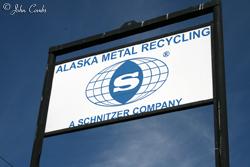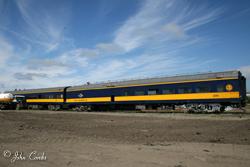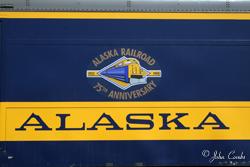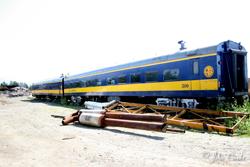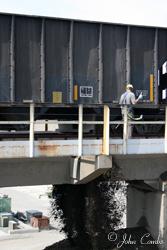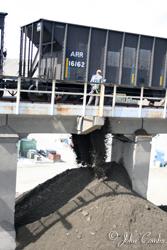Saturday, July 17, 2010
Dave Blazejewski, Alaska Railroad Superintendent of Transportation,
has two hobbies, railfanning and photography. So it goes without saying
that
he really loves what he does for a living. Although his personal passion is
the orange and black Denver and Rio Grande
Western, he readily admits he
has
an obsession for chasing the blue and yellow as well.
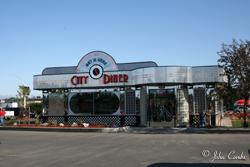 I
must admit that I was one lucky guy in that Dave had graciously agreed to
spend part of his day off doing foamer type things with me. We started our
day with
a hearty breakfast at the City Diner, an adorable 1950s retro style restaurant
which features some great morning eye-openers.
While we waited for our food to arrive, we chatted a bit about railroad operations
and Dave's vision for its future. Dave is yet another example of what draws
me to the Alaska Railroad like a moth to the flame; he absolutely loves what
he does and his excitement is extremely contagious. Even though it was his
day
off, he still answered his cell phone and provided assistance and guidance
for various snafus. He apologized for these interruptions, but I welcomed
them as
they gave me insight into day-to-day operations on the railroad.
I
must admit that I was one lucky guy in that Dave had graciously agreed to
spend part of his day off doing foamer type things with me. We started our
day with
a hearty breakfast at the City Diner, an adorable 1950s retro style restaurant
which features some great morning eye-openers.
While we waited for our food to arrive, we chatted a bit about railroad operations
and Dave's vision for its future. Dave is yet another example of what draws
me to the Alaska Railroad like a moth to the flame; he absolutely loves what
he does and his excitement is extremely contagious. Even though it was his
day
off, he still answered his cell phone and provided assistance and guidance
for various snafus. He apologized for these interruptions, but I welcomed
them as
they gave me insight into day-to-day operations on the railroad.
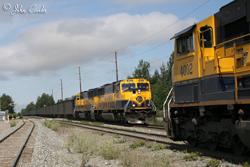 Our
first stop was to check out a train meet. The spot was just south of
the
Raspberry Road crossing (68th). A southbound AS&G gravel
train headed by #4012 roared through while the QAP gravel
train headed by #4002 sat in the Coastal Siding. I had my camera in rapid
fire mode and captured about 25 sequenced photos
of the brief encounter between these massive lumbering giants. Reminder note:
I was wearing all required personal protective equipment (PPE) and escorted
by a railroad employee while taking this photograph. Railfans are reminded
to stay 100 feet away from all railroad tracks.
Our
first stop was to check out a train meet. The spot was just south of
the
Raspberry Road crossing (68th). A southbound AS&G gravel
train headed by #4012 roared through while the QAP gravel
train headed by #4002 sat in the Coastal Siding. I had my camera in rapid
fire mode and captured about 25 sequenced photos
of the brief encounter between these massive lumbering giants. Reminder note:
I was wearing all required personal protective equipment (PPE) and escorted
by a railroad employee while taking this photograph. Railfans are reminded
to stay 100 feet away from all railroad tracks.
We then turned our attention from the living to the dead.
At
Alaska Metal and Recycling (N
61 07.983 W149 52.652) we found counter cafe 300 (built 1959) and diner
400 (built 1949). The railroad had surplused them in
June and now they were waiting for their turn to die. Both cars had Head End
Power (HEP) and seemed in reasonable shape so it was kind of sad to see
their
demise. Number 400 still had its 75th anniversary logo on it.
Side note: A dial on my camera got bumped, which unbeknownst
to me, changed one of its settings. You will notice some of my photos below
are too light or have strange colors. Sorry! Maybe it gives them kind of an
artsy appearance? I finally corrected the problem right before I took the
photo of the CN box car.
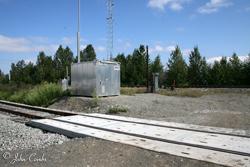 And
then we turned our attention from the dead to new life. Yes, the Alaska Railroad
still sees growth despite a faltering economy. One new customer is Unique
Machine, LLC, Alaska's largest machine shop, which handles manufacturing,
welding and fabrication. Dave was very excited about this new industry,
explaining
they do a lot of work coating and threading pipe for oil and gas wells and
lines. We took photos of the siding (CP1072) which is 1500 feet long and
can hold approximately
18 railcars. As a side note, Unique Machine, in conjunction with Orange County
Choppers, built a special 50th Anniversary of Statehood motorcycle. You'll
find
the YouTube video for this here.
And
then we turned our attention from the dead to new life. Yes, the Alaska Railroad
still sees growth despite a faltering economy. One new customer is Unique
Machine, LLC, Alaska's largest machine shop, which handles manufacturing,
welding and fabrication. Dave was very excited about this new industry,
explaining
they do a lot of work coating and threading pipe for oil and gas wells and
lines. We took photos of the siding (CP1072) which is 1500 feet long and
can hold approximately
18 railcars. As a side note, Unique Machine, in conjunction with Orange County
Choppers, built a special 50th Anniversary of Statehood motorcycle. You'll
find
the YouTube video for this here.
Have you ever wondered what Frederick Mears, Chief Engineer
of the commission for originally building the Alaska Railroad, would have
thought of operations
today? Just think if we could have transported him about 95 years into the
future and he would have popped out at say, Anchorage Sand and Gravel today,
what
would
he
have thought about those monstrous SD70MACs pulling a seemingly endless string
of hoppers dumping tons and tons of gravel? Yes, he would have experienced
quite
an adrenalin rush! I also bet he would have returned to his era with a renewed
spirit knowing the railroad was still going great guns.
Anchorage Sand and Gravel is the bread and butter commodity
for the Alaska Railroad. Since a lot of Alaska is fairly boggy, it needs
gravel to use in roads, parking lots and building
foundations. The railroad
hauls between 2-3 millions tons a year for such projects. Dave was kind enough
to provide me with a ring side seat to view
the dumping operations. I love watching stuff like that. If I worked for A.S.&G.,
I would probably sit here every day and eat my lunch while watching the gravel
drain out of the hoppers
like sands through an hourglass. And for those who love watching videos: dumping
gravel #1 (5.3MB), #2 (7.1MB), #3 (1.9 MB), #4 (9.7MB)
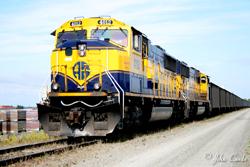 |
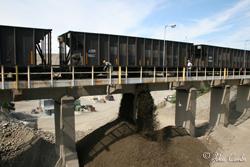 |
|
|
My time with Dave was quickly drawing to a close. He had this crazy idea that
spending time with his wife, who was being deployed tomorrow for two months,
was more
important than railfanning with me. Imagine that! With the time remaining,
I had him drive me through the yard to see what unusual items might
pop up.
We first spied caboose
1084 which was patiently waiting for a future trip to Spencer to become an
office/cabin for the U.S. Forest Service.
Dave needed to stop briefly at the scales house to fix a computer
snafu. This was fine by me since I hadn't seen the railroad's new scales
up close before. After 50 years of usage, the old scales were finally replaced in
2007. You might wonder why the railroad needs scales. Dave himself explains,
"For two reasons. One, for billing purposes. Some customers are billed
on a per ton rate so we need to know how much their load weighs so we can
charge them. Other times customers are billed on a per car rate but they
bill their
customer on a per ton rate. For example, we might charge a flat rate to haul
a gondola load of scrap to Seattle, but a shipper might be billing the mini-mill
per ton. If he doesn't have his own scale the railroad can scale the car
and compute a net weight as a value-added service for which we could then
charge. The second main reason is for safety. We need to ensure cars are
not overloaded for the track structure and the car itself. Each car has a
maximum gross
weight
based on its age, constructions, dimensions, etc. Our railroad has axle loading
limitations and no standard 4-axle cars are permitted to exceed 263,000 pounds.
So even when we aren't billing we always scale outbound loads to ensure they
are safe. Loads coming from interchange are always scaled because all the
big yards weigh cars every time they pass over a hump at a big classification
yard."
Dave pointed out P-30 on a side track
explaining it had a dead prime mover. What is a prime mover you ask? In a
diesel-electric
locomotive
the prime mover refers to the diesel engine that rotates the main generator
responsible
for producing electricity to power the traction motors that are geared to
the drivers. So now you know. The P-30 power car has quite a long history
being a former Burlington Northern E8B built in 1957, now converted to a
HEP power car
with
its
six
axle
trucks
replaced by four axle trucks. My guess is P-30 is not long for the ARR world.
I remember being told that the railroad had been sending an electrician on
each of the special trains P-30 served, just in case anything goes wrong.
It sure seems to spend a lot of time in the repair shop.
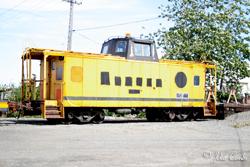 |
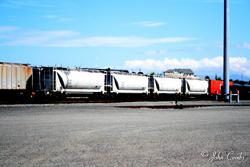 |
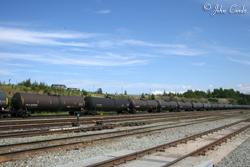 |
| 1084 will soon serve another master |
Covered hoppers |
Tank car infinity |
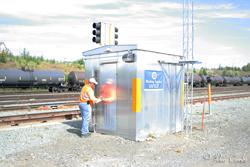 |
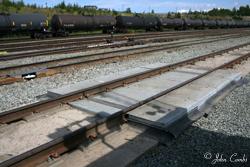 |
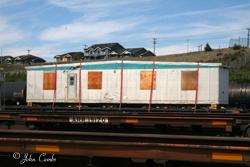 |
| Scale house |
Freight scales |
A truly "mobile" home |
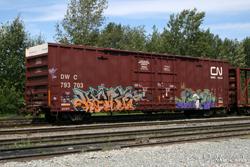 |
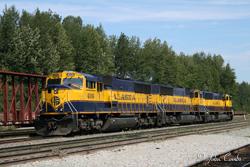 |
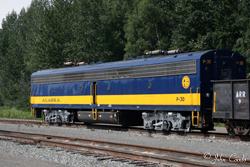 |
| A valuable target for vandals |
I'll have three big MACs with fries please |
P-30 dead on its axles |
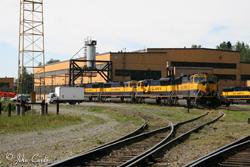 |
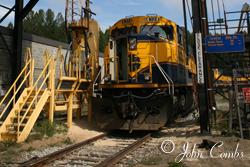 |
|
| MACs and diesel shop |
SD70MAC at the racks |
|
As Dave dropped me off at my car, he mentioned (with a huge
grin on his face) that the Princess train and Coastal Classic would soon
be on Turnagain Arm. As if on cue, I heard the blast of a locomotive horn.
Once again I headed out on the "Arm" in search of the perfect picture. I
just wish I could have had Frederick Mears along with me.
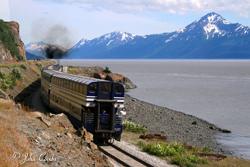 |
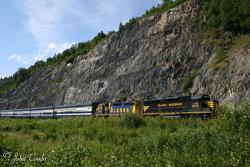 |
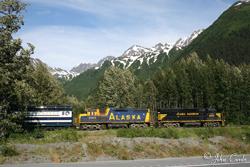 |
| Just starting down the arm |
N 60 59.074 W149 36.114 |
N 60 56.616 W149 10.224 |
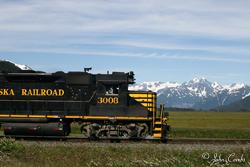 |
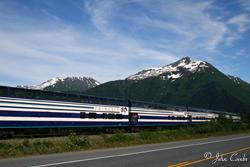 |
And click here for
the 5.4 MB video of the Princess train taken from the Girdwood overpass |
| N 60 53.203 W149 03.036 |
N 60 50.937 W148 59.756 |
|
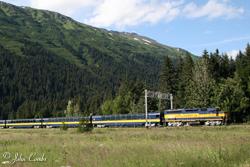 |
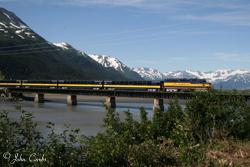 |
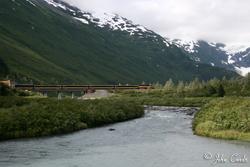 |
| N 60 56.669 W149 10.667 |
At TwentyMile bridge |
N 60 47.218 W148 49.491 |
Returning to Anchorage, I went through my now familiar ritual
of dinner and Wi Fi at Wendy’s. I also had a few extra minutes to snag
a couple of geocaches as well.
Life in paradise had to end sometime. I returned
to the condo to pack my bags for the trip home. I once again thought of
Don and wished we could have shared one final adventure together.
Day 7 | Index
| Day 9
 I
must admit that I was one lucky guy in that Dave had graciously agreed to
spend part of his day off doing foamer type things with me. We started our
day with
a hearty breakfast at the City Diner, an adorable 1950s retro style restaurant
which features some great morning eye-openers.
While we waited for our food to arrive, we chatted a bit about railroad operations
and Dave's vision for its future. Dave is yet another example of what draws
me to the Alaska Railroad like a moth to the flame; he absolutely loves what
he does and his excitement is extremely contagious. Even though it was his
day
off, he still answered his cell phone and provided assistance and guidance
for various snafus. He apologized for these interruptions, but I welcomed
them as
they gave me insight into day-to-day operations on the railroad.
I
must admit that I was one lucky guy in that Dave had graciously agreed to
spend part of his day off doing foamer type things with me. We started our
day with
a hearty breakfast at the City Diner, an adorable 1950s retro style restaurant
which features some great morning eye-openers.
While we waited for our food to arrive, we chatted a bit about railroad operations
and Dave's vision for its future. Dave is yet another example of what draws
me to the Alaska Railroad like a moth to the flame; he absolutely loves what
he does and his excitement is extremely contagious. Even though it was his
day
off, he still answered his cell phone and provided assistance and guidance
for various snafus. He apologized for these interruptions, but I welcomed
them as
they gave me insight into day-to-day operations on the railroad. 
